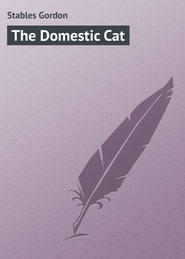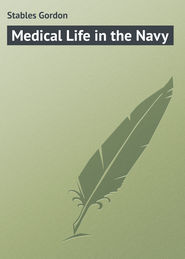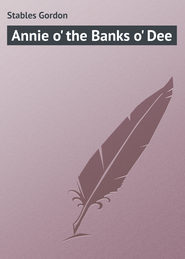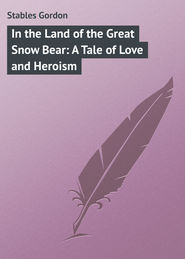По всем вопросам обращайтесь на: info@litportal.ru
(©) 2003-2024.
✖
In Touch with Nature: Tales and Sketches from the Life
Настройки чтения
Размер шрифта
Высота строк
Поля
“Good-night: sound sleep!”
An hour afterwards we were all enjoying that sound repose that only the just, and gipsies, ever know.
Chapter Ten.
Spare the Sparrow
“Ye slay them! and wherefore? For the gain
Of a scant handful, more or less, of wheat.
Or rye, or barley, or some other grain.”
On this grand gipsy-tour of ours we had reason to be thankful every day for a good many things. First and foremost, that our horses were so sturdy, strong, and willing; that the great caravan itself was so comfortable, and the smaller one so snug, and both so delightfully and artistically fitted up, that they looked more like the saloon and cabin of some beautiful yacht than the homes of amateur gipsies.
It took us a whole month to get across the borders and well into bonnie Scotland. But a more pleasant month I for one never spent before nor since. We took it easy. We were determined to study the otium cum dignitate and dolce far niente, and at the end of this month it would have been difficult to say which of us was the hardier or jollier. The horses were sleek and fat, Hurricane Bob spent most of his time either lying among rugs on the coupé with the children, or tumbling on the daisied sward, while the cat did nothing but sing and look complacent. We human beings were so happy, we could even afford to laugh and be gay when thunders rolled, when gales of wind blew and rocked the caravan as if she had been a ship at sea, or when the rain came down in torrents.
Maggie May had already ceased to be an invalid, and Ida had got as brown as if she really were a true-born Romany-Rye.
No, we never hurried the horses. For there was so much to be seen, fresh scenery at every turn of the road, beautiful wild flowers to be gathered to fill the vases. The children at lunch-time even made great garlands of them, and hung them round the horses’ necks.
Of course the village children always took us for a show, and ran out to meet and cheer us, but most grown-up folks took us simply for what we were – a party on a pleasant summer tour.
Mysie, strange to say, although she often stopped out of doors all night, was always back in good time for the start in the morning.
I fear she proved a great enemy to the birds.
One evening she brought into the tent a beautifully plumaged cock-sparrow.
Now I am very fond of sparrows. They are historical birds, and birds of Bible times, so I relieved Mysie of her poor prisoner, and let it flutter away.
We then had some talk about sparrows, and I embody my ideas of them in the following sketch.
The British Sparrow: a study in ornithology.
The sparrow, although it undoubtedly belongs to the great natural family Fringillidae, which includes among its members the weavers and whydah birds, the linnet, the goldfinch, and bullfinch, to say nothing of the canary itself, can hardly be said to rank with the aristocracy of the bird world. Quite the reverse; in fact, the Passer domesticus is a bird of low life. He is by no means a humble bird, however. There is nothing at all of the Uriah Heep about my little friend; he has quite as good an opinion of himself as any feathered biped need to have. Yet if it be possible for some classes of birds to look with disdain on the behaviour and doings of others, sparrows are surely so treated by their betters. And no wonder, for they are neither elegant in shape nor appearance; they do not dress well either in winter or in summer; it is not their lot to be arrayed in scarlet or in gold, but in humble brown and russet grey. So much for the appearance of the bird.
In manners and in deportment sparrows are far beneath bon ton; their knowledge of music is exceedingly limited, their appreciation of sweet sounds conspicuous only by its absence – why, they think nothing of interrupting even the nightingale in his song – and if any bird can be said to talk Billingsgate, those birds are sparrows. Should any one doubt the truth of my last statement, let him go and listen for one minute to the wrangling linguamachy that goes on of an evening after sunset, as they are retiring to roost in a tree.
Yet, for all this, many of the tricks and manners of these plebeian birds are well worth watching, and often highly amusing.
It is not, however, merely to amuse the reader that I now write, but quite as much in behalf of the bird itself. For of late years the character of the British sparrow has been aspersed in this country, but more particularly abroad; and I think he ought to have a fair and impartial trial. I therefore stand forward, not, mind you, as the champion, but the counsel both for and against the prisoner at the bar – the said Passer domesticus, who, on this occasion, is not arraigned for the murder of cock-robin, but for a far more heinous offence, namely, that of constituting himself a common nuisance, and doing more harm than good in the world.
For some years back I have had many – nay, but constant – opportunities for studying the habits of sparrows and many other kinds of birds, and I am not unobservant. I live in one of the prettiest and leafiest nooks of tree-clad Berkshire. The village that adjoins me nestles among trees; the gardens all about the houses are masses of shrubbery and flowers; stone fences are utterly unknown; there are hedges everywhere. Our trees are wide-spreading oaks and planes, drooping acacias, leafy lindens, elm, ash, willow, poplar, and what not.
Up the lordly line of splendid poplar-trees that bound my cosy little paddock the green ivy grows, and here sparrows dwell in hundreds. I do not shoot my wild birds, nor do my children chase and frighten them. Linnets build every year in the laurels close by the dog-kennel: robins feed with the dogs, and some older sparrows know names that we have given them, and come to be fed. No need to hang up boxes for them to build in – we live in the bush; but in summer-time they have a bath on the back lawn, and it is a sight to see them in the early morning. Thrushes, blackbirds, finches, sparrows, starlings – they all agree as well as if they had learned Watts’ hymns, and laid them all to heart. More about my birds another day – perhaps. One starling, however, I must mention here; he comes down every sunny morning, with his wife; he sends her in to bathe and splash; he sits on the edge of the bath and receives the drops – that is all the bath he takes. She is a dutiful wife.
The plumage of the domestic sparrow is almost too well known to need description. In one of the very excellent publications of Messrs Cassell and Co. – viz, “Familiar Wild Birds” – the following remarks occur: —
“The difference in the appearance of the plumage of a country sparrow, as compared with his town-bred cousin, would be hardly imagined, the fresh bright plumage of the one displaying the prettily marked black, white, and brown, whilst smoke and dirt hide the beauty of the town sparrow, so that it is sometimes difficult to distinguish the sex at a glance. The male, however, has a brilliant black throat, and is otherwise more determined in colour, the hen being especially deficient in the bright brown of the wings and the chocolate mark over the eyes.”
This is quite true. The author might have added, however, that the black bib which the male sparrow wears is seldom perfect until June, and the birds pair and build long before they have acquired their summer dresses. They are in such a hurry that they do not wait for their wedding-garments.
Now, this is just the place to mention a fact that I have proved again and again, to my own satisfaction at all events. It is this: sparrows are polygamous; house-sparrows are undoubtedly so, and I believe also so are their first cousins, who build in trees. I myself was reared in the woods and wilds of Scotland, and, like most boys, was fond of bird-nesting. It often used to strike us lads as strange that differently marked eggs were found in the same sparrow’s nest. We did not suspect then that these were laid by different birds. Last week a family quarrel arose among some sparrows in the large wistaria that covers the front of my cottage, and during the row an immense hammock of a double nest was knocked down. When I say a double nest I mean two nests joined in one – a kind of a “butt and a ben,” only with separate doors. One nest was empty – only clean, well-lined, and ready for use. The other contained four eggs – two pairs. They have the distinctive colouring and markings of ordinary sparrow’s eggs, but each pair is different, and the gentleman sparrow who owned that semi-detached cottage has two wives; they have built another and private residence some yards from the old site, and it is to be hoped will live happy ever afterwards.
I have a sparrow who answers to the name of “Weekie,” and who comes to call. This sparrow has three wives.
In many ways he is a remarkable bird. For several winters he has slept on the same rose-twig close under the verandah, with his wives – at first he had but two – not far from him. I used to watch Weekie from a top window sending his wives to roost just at sunset and before he retired himself. He would perch himself on the top of a tall cypress-tree and call them, turning his head this way and that as he hailed them, evidently not knowing from what direction they would come. But they always did come, and after some friendly remonstrance went to roost. About ten minutes after Weekie would give himself a little grateful shake, and hop in under the verandah to his favourite twig.
It was Weekie who first taught me that sparrows build for themselves little shelter-nests – any person in the country who takes the trouble to study these birds can prove to his own satisfaction that such is the case. It is only, however, in frosty weather that the sparrows take the trouble to erect these nests of convenience.
Some two or three years ago we had a very severe frost. During the first day or two I observed straws lying about the verandah; then I noticed that Weekie brought a straw with him at night, and on taking the lamp out to look at him – Weekie meanwhile looking down with one wondering bead of an eye – I noticed that he had his straw over his shoulder. Well, there couldn’t have been much comfort in this, but it was a hint to his two wives, and sure enough they took it, and I saw them building a nest of moss and straw, not larger than half a goose’s egg, around and under Weekie’s twig – not above, because there the verandah sheltered him. Weekie was happy now, I suppose, and warm as to his toes. Weekie’s wives are dutiful wives, but mark this: they themselves had no shelter-nests, and all through the terrible frost-spell they cowered by night within a foot or two of their lord and master – but on bare twigs.
I notice now that these shelter-nests are quite common. A cock-sparrow slept in one last winter in the great Gloire de Dijon rose-tree that covers the northern wall of my stable; but this was built above the perching-twig – it was, in fact, a little arbour.
When they don’t build shelter-nests, sparrows crouch at night under eaves, in ivy thickets, in old nests, and in the holes of trees, which they sometimes line.
The great work of the year – building and bringing forth their young – among sparrows commences early in March, or much sooner, if the weather be fine. But long before this married sparrows who have determined upon a change of residence, and bachelor sparrows who intend to set up for themselves when summer comes, go prospecting around, popping into holes, examining eaves, and chimneys, and ivied trees.
The former take their wives with them, whom they seem to consult and try their best to please, often in vain, for the female sparrow appears to derive a genuine pleasure from house-hunting, and keeps it up as long as possible – till probably the warm weather comes upon them all at once, and they are fain to settle down anywhere.
In the early part of the season the nests are not built very rapidly: about June or July they are often run up in three or even in two days.
The birds seem to have a dreamy kind of happiness in building the first nest, and want their sweetness long drawn out. In fact, it is the honeymoon.
Example: A half-built nest in the wistaria-tree just under a huge cluster of sweet-scented blossom. It is noon, a bright March sun is shining, and up in the tree it is almost as warm as summer. The particular sparrow who owns that half-built nest has only one wife; it is his first season, and hers. They are both young and innocent, not to say ignorant. The foundation of the nest is terribly untidy, exceptionally so. The hen sits about a yard from the nest, with her consequential morsel of a bill in the air, giving her body a little jerk every now and then as if she had the hiccup, and saying “po-eete.” The cock is closer to the nest, busy preening his feathers in the sunshine. Presently he hops into the nest, and has a turn or two round by way of seeing how things are going on. This is a hint to the hen, and excites her to a little more activity, and away she goes to look for a mouthful of building material. She stops on the garden-path to pick up a tiny beetle or two, then hops on to the vegetable beds, shakes up a few bunches of dry couch-grass roots, but finally abandons them for a terribly long and terribly strong wheaten straw. Back to the wistaria-tree she flies with this, half frightened at her own temerity in carrying anything so large. She sticks it up at the side of the nest – it hangs a long way down the tree – and retires to look at it. The cock looks at it too. They both study it.
“It is very hard, isn’t it, my dear?” says the cock at last.
“It is a very fine piece of straw though,” replies the hen, slightly piqued.
“Yes,” says the cock, “as a straw it is certainly a very grand specimen. I admit that. The puzzle is how to work it in.”
So they both sit down with their wise wee heads together, and look at that strong straw, and think and wonder in what possible way or shape it can be made use of. They sit there for quite two hours giving vent only to an occasional suggestive “cheep,” and a jerk of their little bodies as if they both had the hiccup. But at last they suddenly awaken to a sense of their folly. Two whole hours of sunshine lost, and all for a straw! That straw is at once cast loose, and both fly off and soon return with something far more useful, if less ornamental. And so the work goes on.
My sparrows build the main portion of their nests principally with hay, straw, and withered weed roots, but this is mixed and mingled with a variety of other material, rags, pieces of old rope or twine; but paper above all things, especially, it appears to me, tracts and bills relating to cheap sales, because the paper on which these are printed is soft. A long string of white or coloured cloth may often be seen fluttering pennant-fashion from a sparrow’s nest. Some believe this is so placed in order to frighten cats and hawks. More likely it is mere slovenliness. Well, a sparrow’s nest outside does look a most untidy wisp. But there is an art in its very untidiness, and the thickness of the nest renders it cool in summer and warm for a shelter-nest during winter. The amount of feathers crammed into a single nest, particularly that of a tree-sparrow, is often quite astounding.
An old nest is sometimes made to do duty over and over again during the season, but it is always overhauled and re-lined.
Sparrows are not invariably wise in the selection of their building sites. Instance: Two sparrows built this summer in the rose-covered spout of my verandah. A terrible storm of rain came, and the young were drowned in the torrent of water that came from the roof. But I daresay these silly birds think such a thing will not occur again – in their time. At all events, they have thrown the dead birds out to the cat, renovated and re-lined the nest, and there are eggs in it now. I was staying last summer for a week or two with a friend not far from here. There were plenty of martens about, and three nests under the eaves right over my bedroom window. For several mornings I had noticed grains of wheat on my window-ledge, and on looking up towards the nest I noticed feathers protruding. Now, had I been Samuel Pickwick, I should have at once taken out my note-book and made the following entry: – “N.B. The house-martens in Hampshire line their nests with feathers and feed their young on wheat and barley.”
I laughingly told honest Joseph G – , my friend’s gardener, of my discovery in natural history. He was too old a sparrow to be caught with chaff, however.
“It’s the sparrows, beggar ’em,” he said, shutting his fist; “they’re at their games agin. I’ll shoot ’em, I will. They waits till the swallers builds their nests, then they goes and turns ’em out and finishes up wi’ feathers.”
“Don’t shoot them,” I said, “they have young.”
“Indeed, sir, but I will,” cried Joseph G – . “What right has they to turn the swallers out, eh? Fair play, I says, fair play and no favour.”
Some years ago I read that the sparrows in Australia had constituted themselves a kind of plague, and in rather a strange way they stole all the hay to build their nests, and every plan, such as smoking them, and turning the garden hose on the nests, etc, had been tried in vain. We must not believe all colonists tell us. They are noted perverters of the truth. Why didn’t they retaliate and turn the sparrows into pies – a sparrow pie, they say, is a dainty dish. I do not care to eat my sparrows. I believe that killing sparrows is like killing house-flies – others come to fill up the death vacancies.










